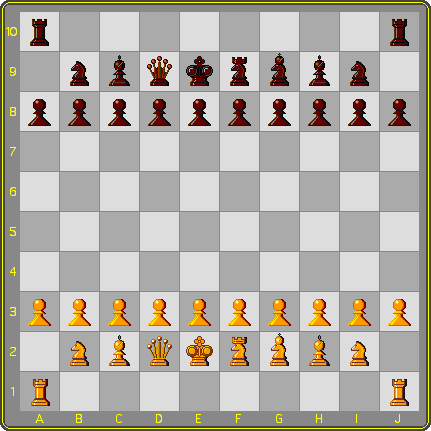 | ||
Grand Chess is a large-board chess variant invented by Dutch games designer Christian Freeling in 1984. It is played on a 10×10 board, with each side having two additional pawns and two new pieces: the marshal and the cardinal.
Contents
- Yournextmove grand chess tour 2016 day 1
- Rules
- Vehre vs Schmittberger 2001
- Fools mate
- Strategy
- References
A superficial similarity exists between Grand Chess and an early version of the historic chess variant Capablanca Chess because the same pieces and game board are used. But differences in start position, rules governing pawn moves and promotion, and castling make them significantly different games.
A series of Grand Chess Cyber World Championship matches was sponsored by the Dutch game site Mindsports. Past title holders included R. Wayne Schmittberger (1998, 1999) and John Vehre (2001). Grand Chess tournaments were held annually beginning in 1998 by the (now defunct) correspondence game club NOST.
Yournextmove grand chess tour 2016 day 1
Rules
The pieces are placed on the players' first and second ranks, respectively, with the rooks alone on the players' first ranks. The pawns are placed on the players' third ranks. Since the rooks are not blocked as much by the other pieces as in standard chess, it is easier for them to activate earlier in the game.
A pawn that reaches a player's eighth or ninth ranks can elect to either promote or remain a pawn, but it must promote upon reaching the tenth rank. Unlike standard chess, a pawn may be promoted only to a captured piece of the same colour. (So, it is impossible for either side to own two queens, or two marshals, or three rooks, etc.) If, and for as long as, no captured piece is available to promote to, a pawn on a player's ninth rank must stay on the ninth rank, but it can still give check. (This is analogous to the ability of a piece to give check even when the piece is absolutely pinned.)
As in standard chess: pawns can move one or two squares on their first move; pawns can capture en passant; checkmate is a win; stalemate is a draw. There is no castling in Grand Chess.
Vehre vs. Schmittberger, 2001
Played between John Vehre and R. Wayne Schmittberger at the 2001 Grand Chess Cyber Championship Final:
1.f5 f6 2.Nh4 Nh7 3.g4 g7 4.Nc4 Nc7 5.d4 d7 6.e5 Bd8! 7.Rje1 Kd10 8.Kf1 fxe5 9.Ncxe5?! Kc9 10.Re2? Kb9 11.Kg1 Rjf10 12.Bd3 e6 13.Rf1 Mh10?! 14.Nc4 Ci10 15.Nd6 exf5 16.Bxf5 Bd5 17.Ci1 Bxh4 18.ixh4 g6? 19.Rfe1 gxf5 20.Nxf5! Qd8 21.Bxc7 Qxc7 22.Re9+ Kc10 23.Cxc7 bxc7 24.Qf4 d6 25.Qe3 Mg8 26.Me2 Nf6 27.Qe7 Nd7 28.Qe8+ Mxe8 29.Mxe8 1–0 [Annotations by Vehre]
Fool's mate
1.Cf4 Qd10 2.Ce6 Qf10?? 3.Cxc8#
Strategy
H. G. Muller suggested the following estimated piece values:
